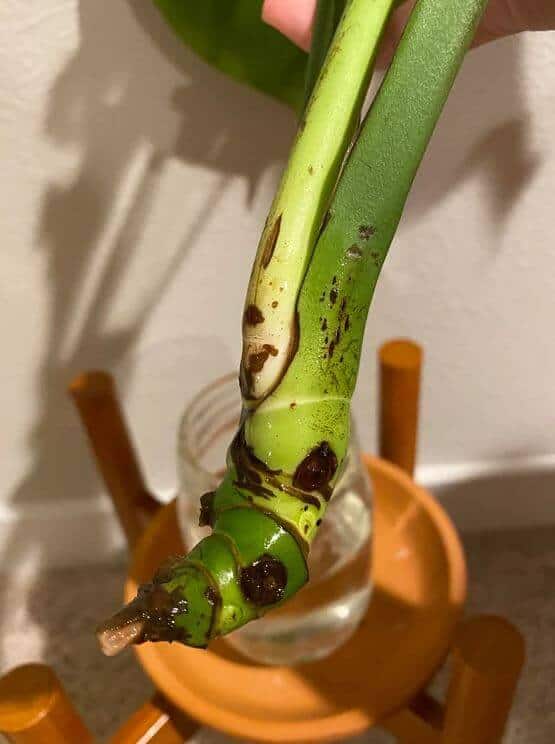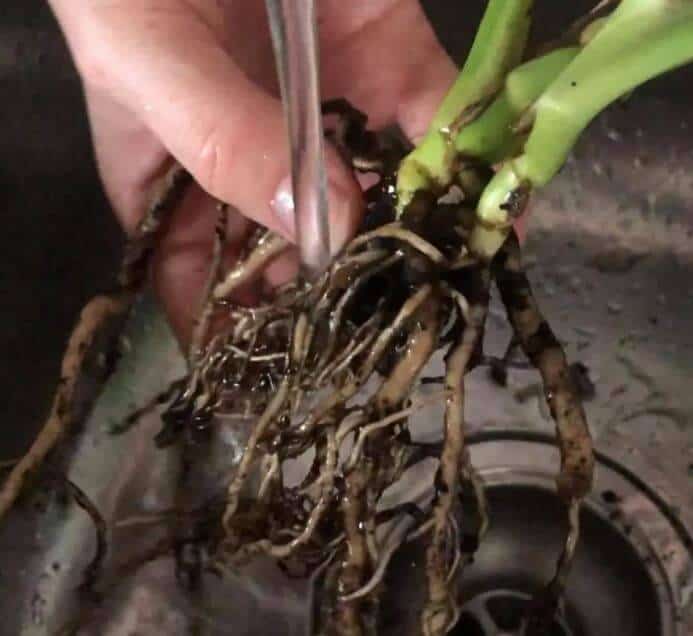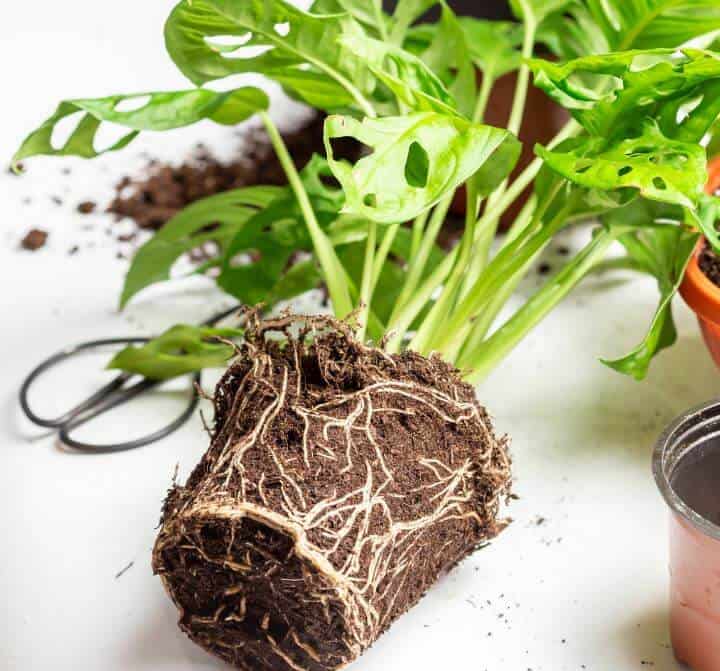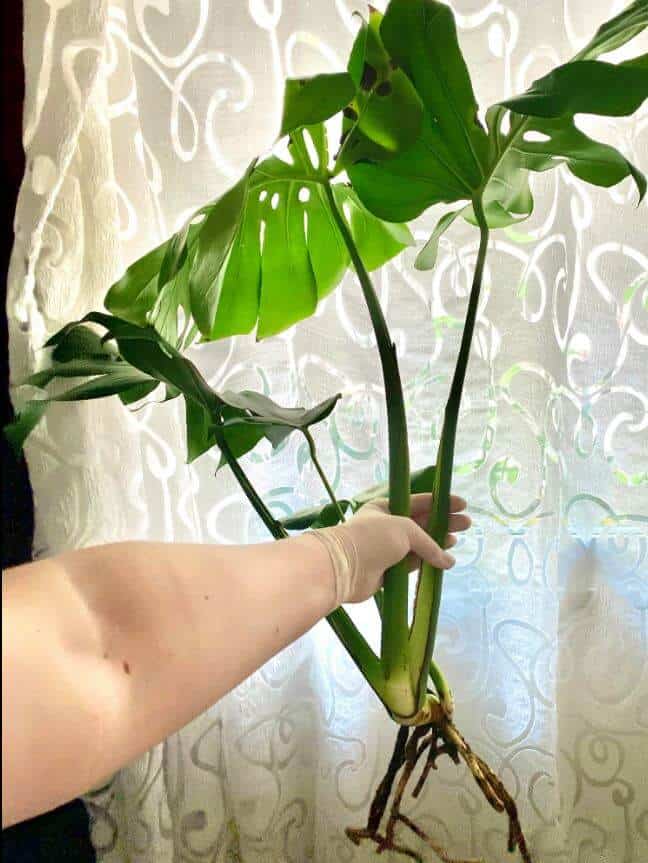Last Updated on August 7, 2023 by a Friendly Gardener
Stem rot is a fungal infection that damages plants but when left untreated, can be fatal. Once your Monstera has developed stem rot, a quick intervention will permit you to save your plant. However, this is a serious disease.
Prevention is always the best course of action, but sometimes it’s difficult to foresee all dangers. It’s essential to examine your Monstera regularly and identify the symptoms, then act fast. You’ll also need to indulge your plant with some aftercare to restore it to full health.
What Is Monstera Stem Rot?

Stem rot is a fungal infection caused by fungi present in the growing medium or potting soil. It may begin at the root system and work its way up to the stem. It will attack foliage and eventually kill the plant. As these pathogens are generally found in the soil, this infection will initially manifest itself at the bottom of the plant.
What Causes Stem Rot in Monstera Plants?
Stem rot will appear due to a combination of environmental factors that can be controlled to prevent its development.
Overwatering

The most common cause of stem rot is wet, soggy soil due to overwatering. Waterlogged soil is the perfect environment for fungal pathogens to thrive and replicate, attacking root systems and plant stems. If you suspect excess moisture is to blame, reconsider your watering schedule. Take a cue from your Monstera as to when to water. Wait until the soil bed dries out somewhat before watering.
Soil Quality and Conditions
The kind of soil you plant your Monstera in can also create a risk for Monstera stem rot. Soil should be loose, well-aerated, and well-draining. Dense soil can retain too much moisture leading to overwatering and fungal infection. Old, compacted soil can also impede drainage. Moldy soil as well as dirty plant containers can all contribute to the ideal conditions for stem rot development.
Environmental Temperature
Fungal infections are facilitated by warmer climates that measure above 70°F. While this can be difficult to modify when cultivating indoors, avoiding overwatering, and using well-aerated soil can stave off infection. Loose soil permits air pockets to form in the soil bed keeping roots well-aerated with lots of oxygen and will aid in maintaining soil temperatures balanced.
Is There a Difference Between Root Rot and Stem Rot in Monstera Plants?

No, there is not a significant difference between root rot and stem rot other than the infection’s location. Root rot is usually confined to the root system. When the plant has developed stem rot monstera fungal infection has progressed. When stem rot appears, this means the root system is already infected and compromised.
Can a Monstera Plant Sick with Stem Rot Be Saved?
In many instances, yes it can. If you note the root rot early n before it has compromised stems, you can intervene to save the plant. When the stems begin to rot, you’ll need to be rapid and aggressive in treating the Monstera. When the stems are affected, you will not be able to save the entire plant, but perhaps a part of it. If you do nothing, the plant will die in a few weeks.
Monstera Stem Rot Symptoms

Early detection is crucial to saving your plant. Early stem rot symptoms include:
Monstera with health issues stops growing to save energy to fight off an infection. This is especially true during the growing season in spring and summer.
-
Wilted, discolored leaves
Fungal infections can cause black, or dark brown, soft spots and patches on foliage. They will then wilt. The infection will most likely attack lower foliage first. If you note this, check the condition of the roots.
-
Mushy, dark-hued roots
Unpot your plant. Root rot in monstera is characterized by dark, mushy, and smelly roots.
-
Black or brown stems
If stems begin to darken and turn soft, the fungal infection has progressed.
-
Smelly soil
A musty, foul smell emerging from the soil bed, means roots are infected.
How to Fix Root Rot Monstera

It’s essential that you clean the healthy part of the root system.
- Unpot your Monstera away from all other houseplants. Do not pull the plant out by the stems but ease it out gently.
- Remove as much soil from the root ball as possible.
- Rinse the root ball thoroughly with tepid water.
- Wearing gardening gloves, trim off infected, rotting roots. These include smelly, mushy, soft, or dark-colored roots. Use sterilized scissors to prune. (Re-sterilize your scissors when you have finished.) Trim above the rotted parts. Do the same with rotted stems and leaves.
- Dispose of the rotted part plants in the trash. Do not use them for compost.
- Repot your Monstera using a sterilized container and fresh potting soil that is loose and well-draining with a pH between 5.5 and 7.
- Water your plant sparingly.
Once you have repotted the healthy part of your Monstera, place it in generous, indirect bright sunlight. While your plant is recovering, water sparingly allowing the soil bed to dry out a bit more, to approximately three inches deep. Also, avoid feeding your plant for a month or two after pruning the root ball and repotting.
Powdery Mildew on Monstera Plants
When a Monstera develops white spots on foliage, it most likely has a case of powdery mildew. This is another type of fungal infection and is quite common. This kind of fungus thrives in warm, dry environments. Powdery white growth will appear on stems and leaves because fungus spores landed on your plant and found a welcoming environment.
To treat your monstera, begin by cleaning the affected foliage and stems with a moist cloth. You can also use a jet spray of water to remove the fungi. Proceed to treat your Monstera with a fungicide. Neem oil is a natural, organic fungicide (and pesticide) that is not harmful to humans or animals. Continue the application of the fungicide for at least two weeks until all spores have been killed or removed.
To prevent the return of powdery mildew:
- Increase ventilation of air circulation near your plant.
- Water your Monstera in the mornings.
- Water at the plant’s base and not overhead.
- Ensure your plant has adequate bright, indirect light.

